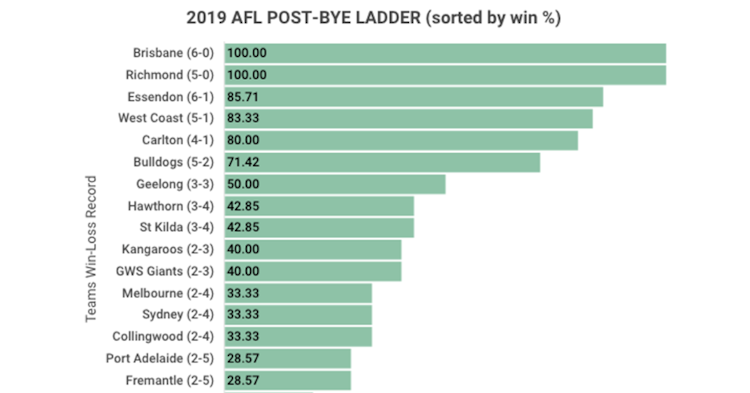How much does late season form affect a club's AFL Premiership opportunity?
Last updated: Aug 7, 2019, 1:35AM | Published: Jul 29, 2019, 4:45AM
The pre-bye-period AFL landscape was one utterly ruled by one team, Geelong, with Collingwood appearing to be the biggest threat to complete dominance. It was a universe where Carton was odds-on wooden spoon favourite, and where Richmond was - incredibly - sitting outside the top eight.
It was a league where at the conclusion of round 14, Essendon sat tenth and the Western Bulldogs 13th on the AFL Ladder.
This post-bye AFL universe, however, is one with a vastly different complexion.
In this world, West Coast, Richmond, Brisbane, Essendon and the Bulldogs have emerged as the competition’s most in-form teams.
It is a world where Geelong still occupy the top spot on the ladder, but whose form is now comparatively fragile, and whose premiership chances according to the Stats Insider AFL Futures model have slipped to 'just' 21.2%.
In this post-bye universe, Carlton has put to bed any notions of yet another wooden spoon heading to Princes Park, while this run has been particularly cruel to the South Australian teams, with both Adelaide and Port Adelaide combining for a 3-9 record over the last couple of months.
However, the biggest post-bye landscape alteration has occurred with Collingwood, who seemingly, have fallen to pieces on the back of an injury crisis and untimely suspension.
AFL FUTURES: Where is your club placed heading into September?
The Pies spent 14 consecutive rounds perched safely inside the top four, however - after losing four of their last six matches - have dropped all the way to sixth on the ladder with the Premiership model now giving them just a 6.7% chance of glory. That number was as high as 18.2% at the conclusion of Round 12.
<ad>
So, the question is, not just for Collingwood, but all of this year’s contending teams; how much stock should we place in late-season form?
Does it matter if your team is experiencing something of a post-bye lull, but who’ll still be good enough to qualify for September where anything’s apparently possible?
The answer is that it matters greatly.
And, if you're not winning at this time of the season, you better start winning soon.
In fact, there’s an exponential correlation between a club’s second-half form and their ability to either win the flag - or at a minimum - play-off in the Grand Final.
Since 2012's introduction of the current bye-week structure, we have seven seasons of post-bye data which draws an undeniable parallel between late-season home and away form, and AFL Premiership success.
Here are the post-bye win-loss records by the eventual premiers, since 2012.
2012 Sydney: 8-3
2013 Hawthorn: 10-2
2014 Hawthorn: 11-3
2015 Hawthorn: 10-2
2016 Bulldogs: 6-3
2017 Richmond: 8-3
2018 West Coast: 6-5
Each recent premier was clearly taking some pretty excellent form into September. Even the Bulldogs - who have been perceived to have limped into their Premiership campaign, put together a 6-3 post-bye record, with the Eagles having the most underwhelming mark at 6-5. Yet, even then, three of those five West Coast losses came immediately after the bye with the club actually taking a 6-2 record directly into September.
It’s a similar story with the eventual runners-up, with all seven bridesmaids boasting equally compelling post-bye records.
2012 Hawthorn: 9-1
2013 Fremantle: 9-2
2014 Sydney: 11-2
2015 West Coast: 7-2
2016 Sydney: 7-2
2017 Adelaide: 6-3
2018 Collingwood: 7-3
The 14 Grand Final teams over the last seven seasons have, in fact, combined for a 108-36 record which translates to an incredible 75% win rate.
If we go back a little further to the period between 2000 and 2011, and before the introduction of the current bye format, we also see a staggering correlation between the way a club finished off their home and away campaign, and what they were able to produce come Finals time.
The 24 Grand Final teams between 2000 and 2011 produced a combined 211-63 record in the second half of their home and away seasons, translating to an incredible 77% win rate.
<ad>
Once again, the stats are indicating that if you want to play off for an AFL Premiership, mediocre form late in the season simply won't cut it.
Which brings us back to how the AFL landscape in 2019 is shaping up, post-bye.

We see five teams (Brisbane, Richmond, Essendon, West Coast and the Bulldogs) who have posted a win rate of 70% or better since the bye while the remaining contenders have either 50% win records or worse.
Thankfully for the contending teams, there are still four home and away games to play with opportunities to rediscover their form and reignite their premiership aspirations.
In this realm, a team's 'strength of schedule' will be paramount, with Stats Insider's own 'Schedule Difficulty' algorithm presenting some good news for the likes of Collingwood and the Giants who have both fallen out of the top four since the bye.
STRENGTH OF SCHEDULE: How difficult is your club's run home?
Both teams are assessed as having the leagues' two easiest runs-home, providing both with a golden opportunity to reclaim the valuable finals double-chance, as well as a way to massage their win-loss records into something resembling what Grand Final teams have historically looked like.
If the latter part of the AFL season has taught us anything this decade, it's that AFL Finals competition is no place for slumping clubs, playing mediocre footy.
If your club wants to make some noise in September, they better be winning in July and August.
Drop a comment at the bottom of the page (or on Twitter / Facebook) to tell us where you think the value is this week 👇



